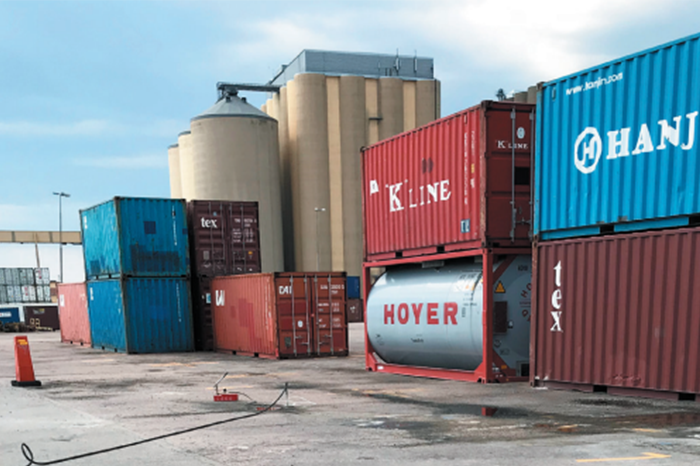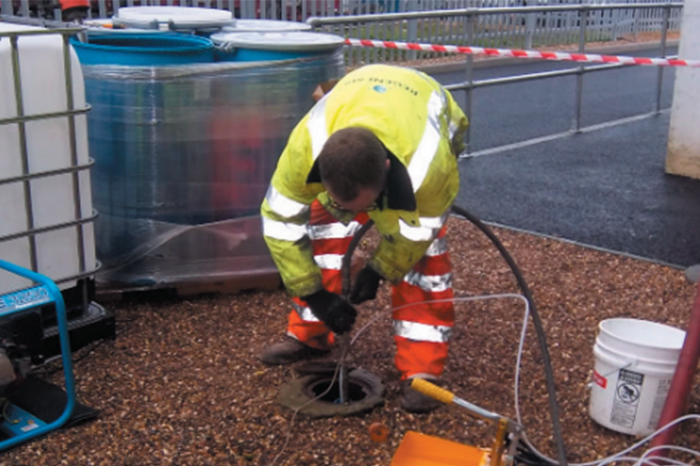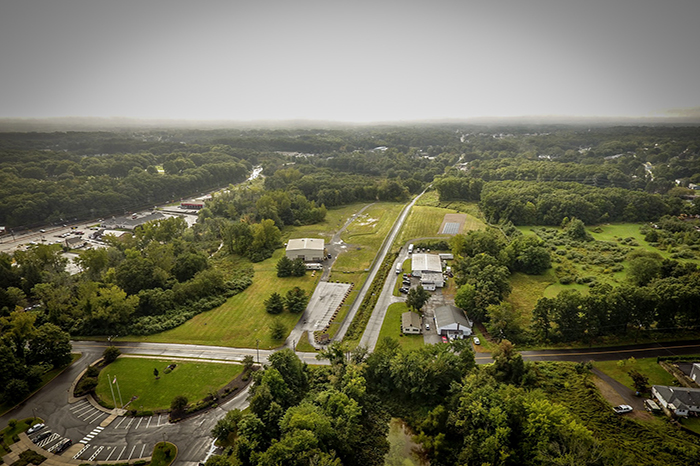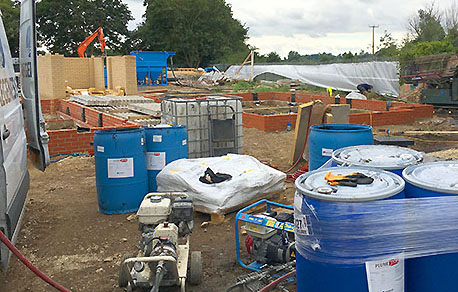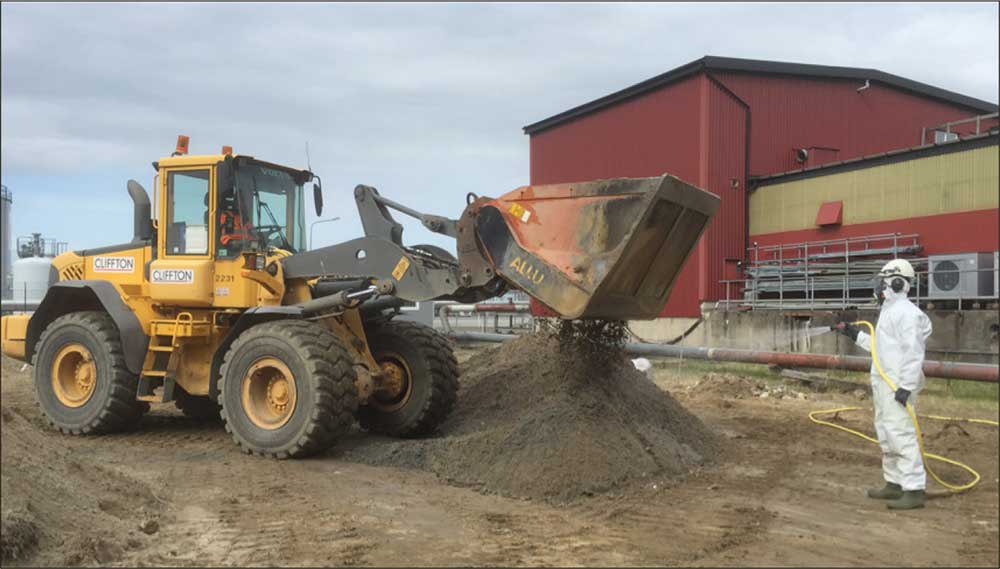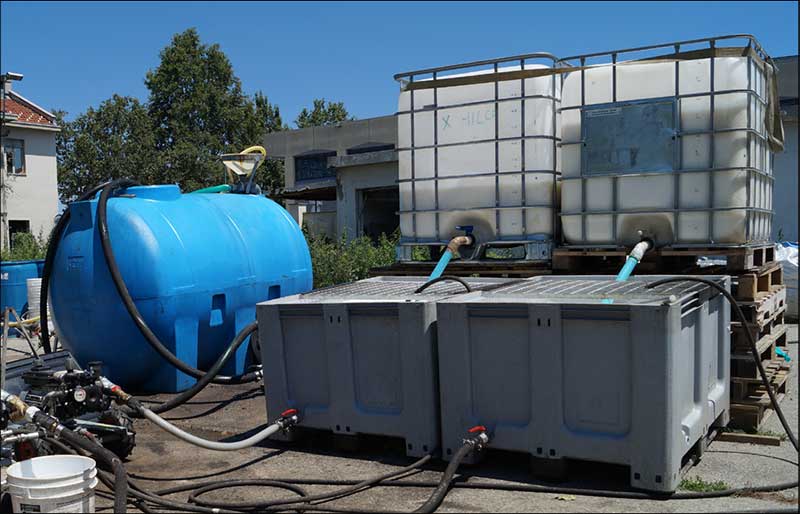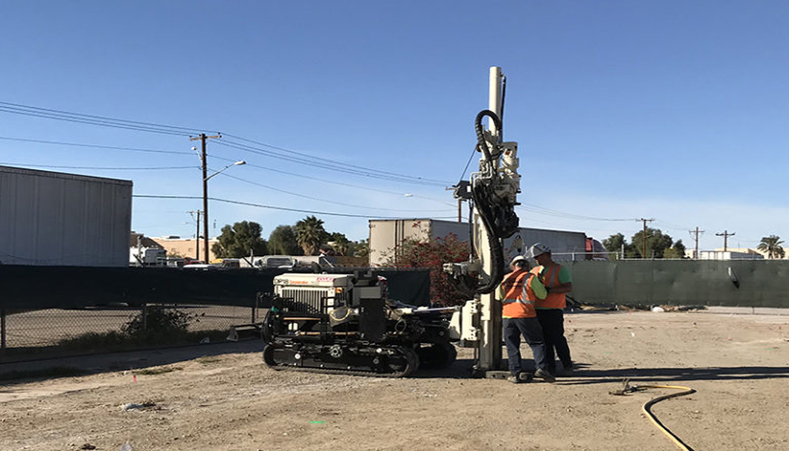Combined Remedy Treats TCE Plume at Aerospace Site
Case study highlights:
- Combined remedy was three times the cost savings vs. alternative remedial technologies being considered
- Completed the application event ahead of schedule
- Successful reductions in cVOCs observed
This case study reviews an aerospace manufacturing facility in Southern California that required remediation for a deep and heavily impacted Trichloroethene (TCE) plume. The extensive depth and size of the plume contributed to the difficulty facing remediation efforts, with much of the contaminant plume extending offsite. Alta Environmental and REGENESIS began developing an approach to remediate this site in 2012. After conducting pilot tests, they concluded that Enhanced In-Situ Bioremediation (EISB) technology was both cost-effective and feasible for successful remediation of this site. The observation wells continue to be sampled quarterly and are displaying successful reductions in cVOCs.
In Situ treatment of toluene in groundwater, Helsingborg, Sweden
In Situ reagent barriers (HRC) treat contaminated groundwater in sandstone under a schoolRead More
Integrated in situ remediation of honing oil in a chalk aquifer, UK
In Situ reagent barriers (HRC) treat contaminated groundwater in sandstone under a schoolRead More
Significant Reduction in VOCs Achieved at Rail Site
Case study highlights:
- First application of PlumeStop® and AquaZVI™ globally
- Despite wintery weather conditions at the Rail Site in Northern Quebec, the amendment delivery and distribution was successful
- Over 95% decrease in dissolved and saturated soil VOC concentrations
- Thorough data analysis including ISMs and CSIA confirmed definite contaminant degradation
This case study reviews a contaminated rail site in Canada that had released chlorinated solvents in groundwater. WSP conducted a pilot test at the site to assess the applicability of a brand-new technology that optimizes delivery of amendments using hydrocolloids. The pilot test would determine the applicability of a passive treatment barrier using PlumeStop and AquaZVI. A combined remedy approach was chosen because it optimizes the use of colloidal activated carbon and zero valent iron, allowing for the highest treatment efficiency at the lowest possible cost. After conducting the pilot test, data for samples collected within the treatment barrier indicated significant contaminant concentration decreases in groundwater and saturated soil.
In Situ Remedy Addresses PFAS Risk at Superfund Site
Case study highlights:
- Estimated savings of $400,000 annually as a result of halting pump and treat operations
- PlumeStop quickly reduced PFOS/PFOA levels and in combination with AquaZVI eliminated VOC contaminant concentrations
- Extension of the popular Rails to Trails route now runs through the property, as a result of successful remediation efforts
This case study reviews remedial programs undertaken at the Solvents Recovery Service of New England (SRSNE), where soil and groundwater were contaminated with VOCs and PFAS contaminants. The site was placed on the National Priorities List in 1983 and by 1991, all activities stopped as the site ceased operations. Since shutting down, the site has benefited from significant remediation efforts. In 2018, an innovative remedial approach incorporated natural attenuation with the use of PlumeStop® to work with an existing sheet pile structure to limit the mobility of the plume and effectively treat contaminant concentrations. PlumeStop quickly reduced PFOS/PFOA levels and in combination with AquaZVI® eliminated VOC contaminant concentrations. It is estimated that the PRP group involved will save $400,000 annually with the shut down of the pump and treat system on site.
Redevelopment of former gas works unlocked by combining technologies
Integrated remediation strategy provides rapid and cost-effective clean up
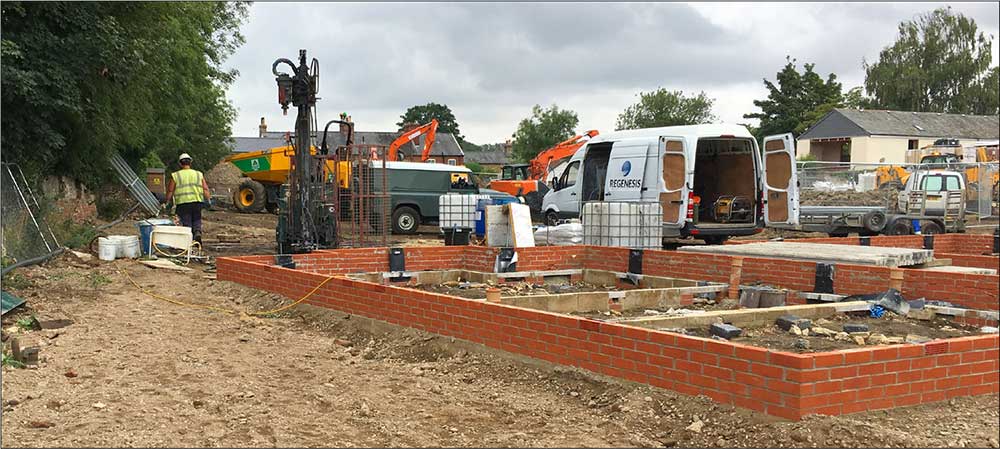
- During the construction of multiple residential dwelling it became apparent that a historical gas works had previously occupied the site.
- A targeted site investigation needed to be completed quickly to identify the areas requiring remedial action, enabling construction to continue in plots outside of the plume.
- A combined remedial strategy was required to address soil, LNAPL, DNAPL and dissolved phase contamination.
- The implementation of the treatment had to be completed around partially completed housing and live underground services.
- The remedial works had to be completed quickly in a manner as to not impact the build program.
- The strategy needed to provide appropriate protection to both human health and controlled waters.
- The need to respond and act quickly required excellent communication and good working relationships to be established between the consultant, stakeholders, regulators and multiple specialist remediation contractors and suppliers.
Remedial Approach
A wide range of remediation technologies were deployed sequentially and in parallel to provide the most rapid and cost effective clean up:
- Ex situ bio-piling of hydrocarbon impacted soils
- LNAPL skimming
- Pump and treat (P&T) of dissolved phase contamination
- DNAPL pumping and settlement/collection
- Enhanced abstraction of contaminant mass using PetroCleanze
- In Situ chemical oxidation (ISCO) using RegenOx, which is compatible with footings and services already in place
- Accelerated aerobic natural attenuation using ORC Advanced slurry
- Accelerated aerobic natural attenuation using a pelletised oxygen-release compound (ORC Advanced) placed in the backfill
- PlumeStop Liquid Activated Carbon injection to install a subsurface activated carbon filter to adsorb and biologically degrade dissolved phase contamination
- Gas vapour membrane installation
Ex situ treatment
The impacted materials within the unsaturated zones within Plume A and B were excavated and placed in a biopile for onsite treatment (Figure 1). Nutrients were added and the biopile was turned until remedial targets were achieved. The soils were then backfilled under the CL:AIRE Code of Practice. Prior to backfill with the remediated soils, ORC Advanced Pellets were added to the base of the excavation. This provided a source of dissolved oxygen for up to a year, stimulating the growth of an effective aerobic biomass and accelerating the degradation of the petroleum hydrocarbon contamination.
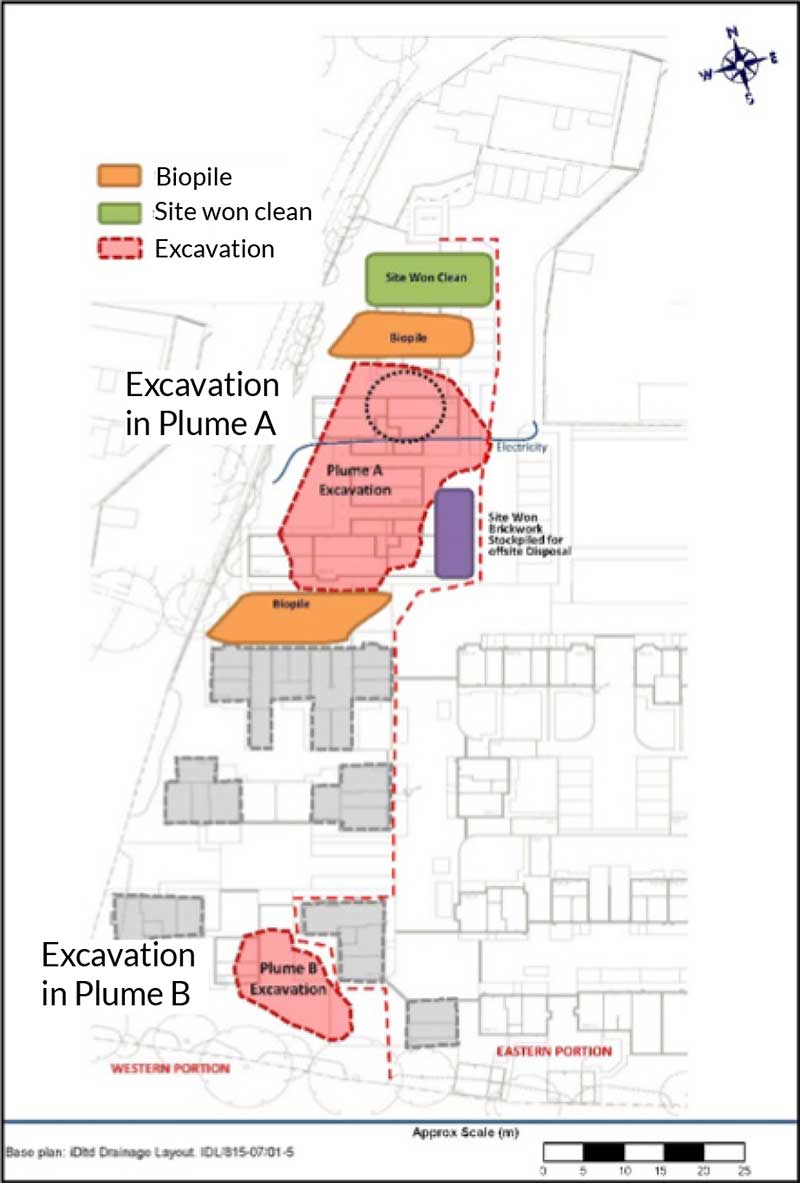
In Situ Treatment
The southern part of Plume A was made inaccessible by footings and services; here in-situ treatment was completed accommodate these obstructions without compromising treatment efficacy. Within Plume B, where high levels of contamination had been encountered (Figure 2), several in situ remedial actions were taken as appropriate to concentration, location and sequence in the strategy:
- REGENESIS injected PlumeStop, a micron-scale colloidal Liquid Activated Carbon substrate along the western margin of the site via direct push to protect the offsite surface water. PlumeStop creates a subsurface activated carbon filter which adsorbs the contaminant influx, which is then degraded by the microbial growth on the carbon biomatrix. Biological degradation was also accelerated through co-application of ORC Advanced and the presence of the pelletised ORC placed in the base of the excavation upgradient, providing a controlled release of oxygen.
- Where LNAPL and high dissolved phase concentrations were observed, a network of injection boreholes were installed by Rake Remediation/REGENESIS. Many of the wells were installed by removing suspended floors and lifting in a mini-rig to complete the drilling beneath partially constructed dwellings. Through these wells, multiple applications of RegenOx were completed. This in situ chemical oxidant was chosen as it was safe to handle on this busy site and would not corrode services installed at the site, nor would it be detrimental to the concrete footings.
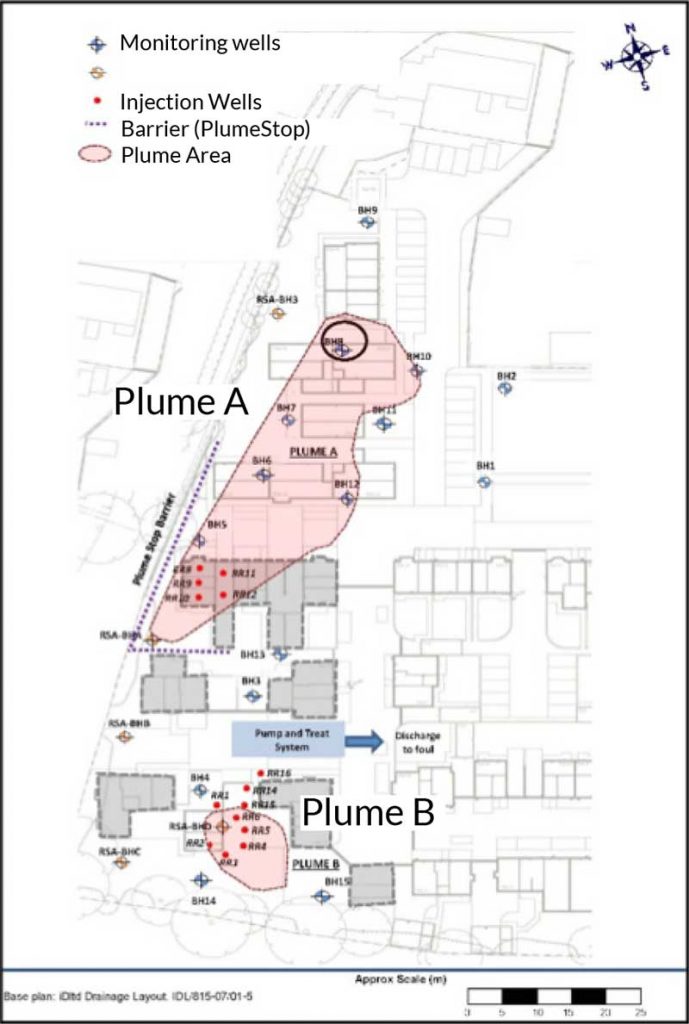

- Following the ISCO, ORC Advanced slurry was injected to enhance the natural attenuation (ENA) of the residual dissolved phase contamination to low levels.
- In Plume B, high levels of contamination in the form of both L- and DNAPL were encountered. This was removed using a P&T system augmented with PetroCleanze, an inorganic surfactant that uses a high pH, carbonates, silicates and partial oxidation to remove contaminants from soils. The PetroCleanze was injected to produce a temporary desorption event, which once observed, allowed the P&T system to be switched back for a short period to remove the contamination. This process was repeated three times to maximise the efficacy of the P&T and shorten the treatment programme.
- Once the NAPL was removed, multiple rounds of RegenOx were completed, followed by ORC Advanced via injection through wells.
- Long term groundwater monitoring programme was put in place to monitor the effectiveness of the clean-up.
Results
The following graphs (Figures 7 and 8) show the variations in concentrations for selected priority contaminants of concern over the monitoring period for Plume A and B. These show a marked reduction in the hydrocarbon dissolved phase concentrations over time, with compliance achieved with the remedial criteria.
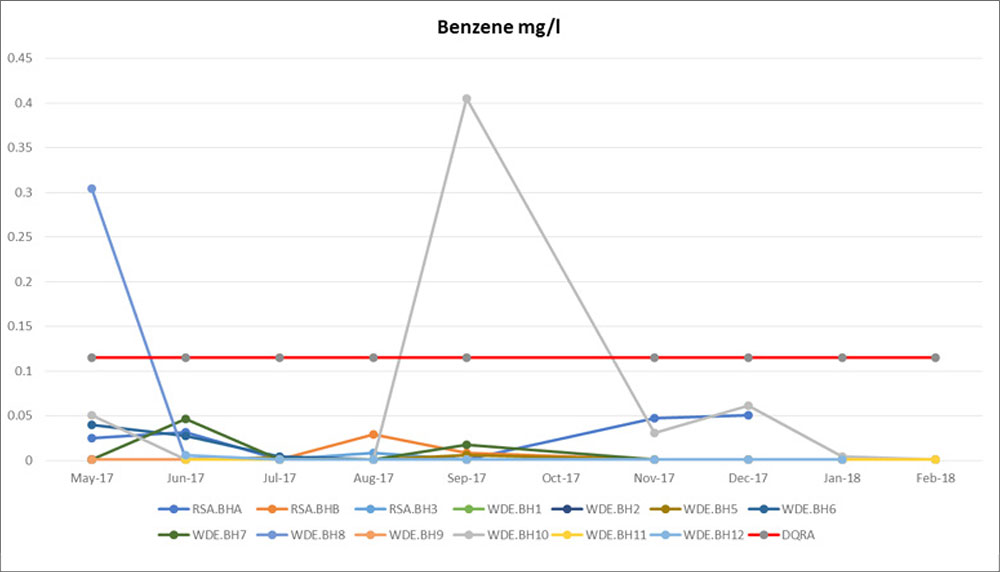
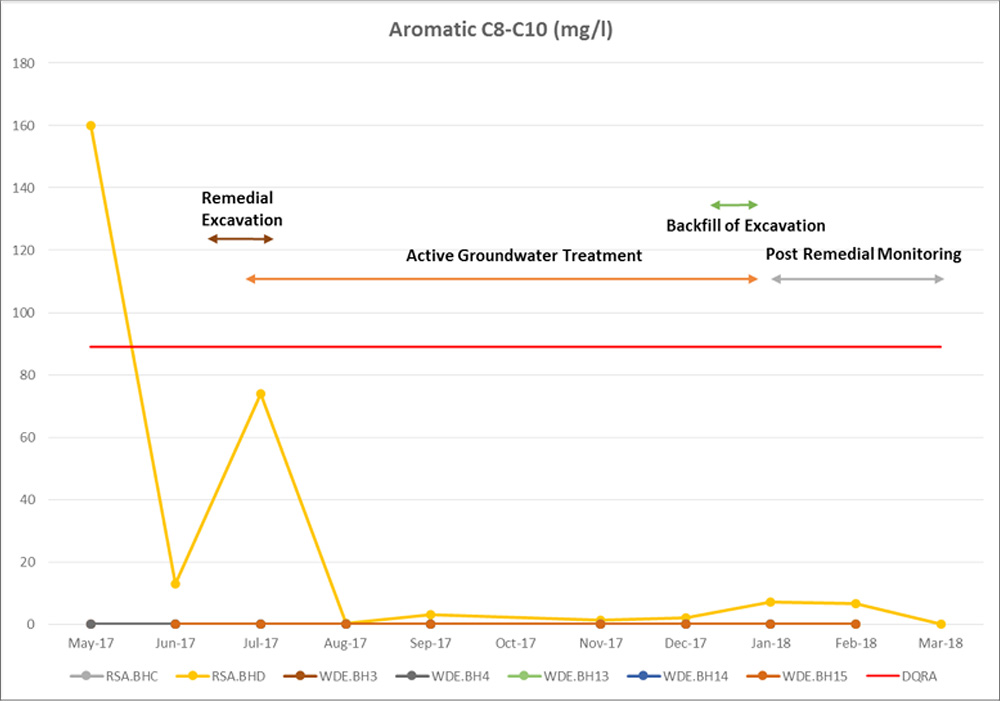
Conclusion
Complimentary remedial technologies were combined successfully to achieve:
- Contaminant mass reduction to below remedial targets in the soil and groundwater within 6 months.
- Protection of onsite and offsite receptors.
- Written confirmation by the Environment Agency that they ‘agree with (the reports’) conclusions’ and that ‘development may proceed’.
- Remediation completed on a tight budget – as remediation had not been foreseen by the developer.
- Ex-Situ remediation of soils and their reuse on site under the CL:AIRE CoP avoided offsite disposal of ~800m3 to landfill.
- In Situ enhancement of the P&T system, minimising the time, cost and volume of abstraction required.
- By combining the technologies intelligently, both simultaneously and sequentially, the programme length was minimised – allowing construction to continue within only 6 months.
Ex Situ Chemical Oxidation of Soils at a Fuel Storage Depot, Sweden
With RGS Nordic

Summary
An area of impacted soils was discovered at an oil-distribution depot at a Swedish harbour. This was thought to have occurred due to historic spillages and leaks from industrial land use on the site. Remediation of the soils was required to MKM levels (Swedens generic industrial land use clean-up criteria).
Download pdfAs the contaminated soil was quite shallow (1.0-2.5m BGL) it was determined that excavation would be easily achieved. Treatment of the soils through biopiling or windrows was not deemed appropriate due to limited space. Therefore ex situ mixing of the soils with a chemical oxidant, PersulfOx, was chosen in order to provide rapid reduction of the contaminant mass. This would be followed by a short period of enhanced biological degradation in the treated soils, stimulated by the increased redox in the soil moisture following the chemical oxidation process. Partial chemical oxidation of the hydrocarbons into more bioavailable and biodegradable compounds would also accelerate biodegradation of a proportion of the residual contaminant mass.
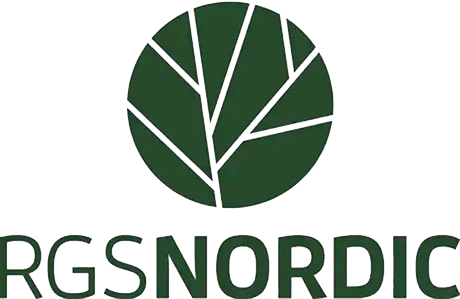
PersulfOx was added into the soils at a dosage rate of 17kg per 1m3 of soils. This was then mixed thoroughly using an Allu hydraulic bucket, during which the soils were wetted. This would increase the soil moisture in order to facilitate the chemical reaction. Care was taken to avoid adding too much water and risk damaging the geotechnical properties of the soils.
The sides and base of the excavations were validated to delineate the vertical and lateral extent of the impacted zone and ensure that all of the contaminated soil had been removed. Following application of the PersulfOx, the treated soils were then placed back into the excavations and validated. Following successful validation, the soils were compacted to the required capacity in order to allow site traffic to pass over the treated areas.
Results
Sampling of the soils three months after treatment, showed that the target concentrations had been reduced to below the target guideline values, see Figure 1 and 2.
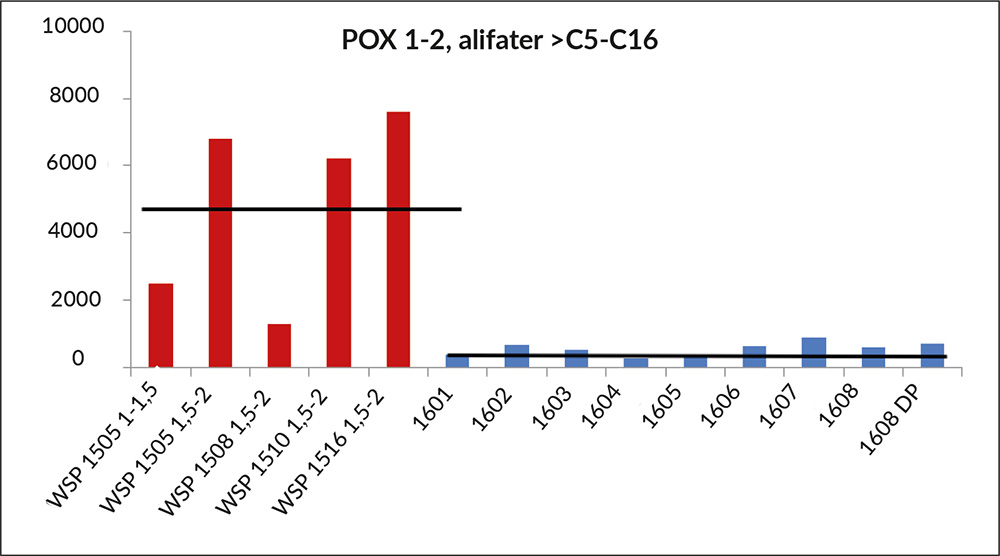
Fig. 1: Combined results from both areas, Aliphatic C5-C16
- The impacted soils were successfully remediated in a short period of time.
- Due to its built-in catalyst, the use of PersulfOx avoided the need for dangerous activators such as hydrogen peroxide or caustic soda, making the remediation process much safer.
- The treatment area was minimised, making the remediation of the soils practical and avoiding greater disruption to the site operator.
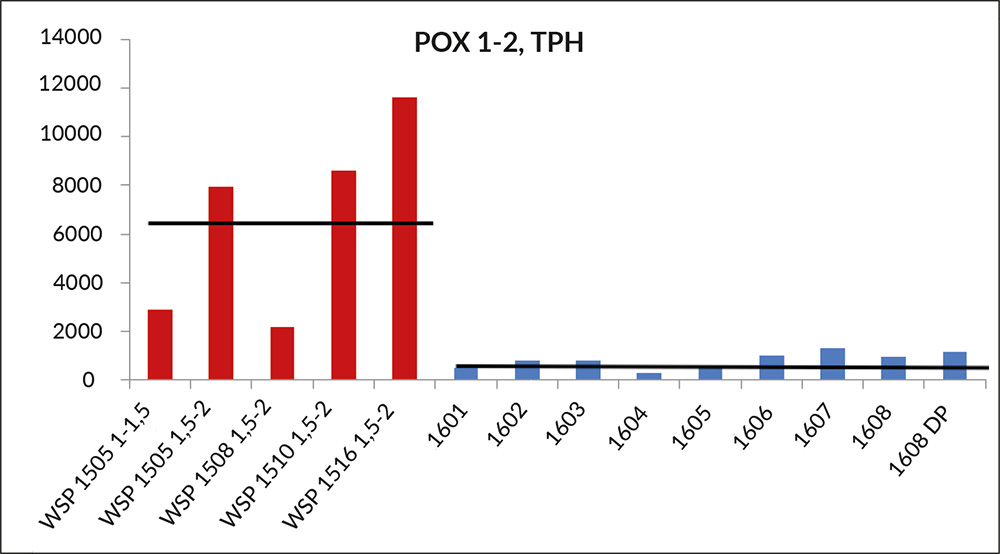
Fig. 2: Combined results from both areas, Total Petroleum Hydrocarbons
In Situ Treatment of Chrome(VI) Plume in Fast Flowing Aquifer, NW Italy
Summary
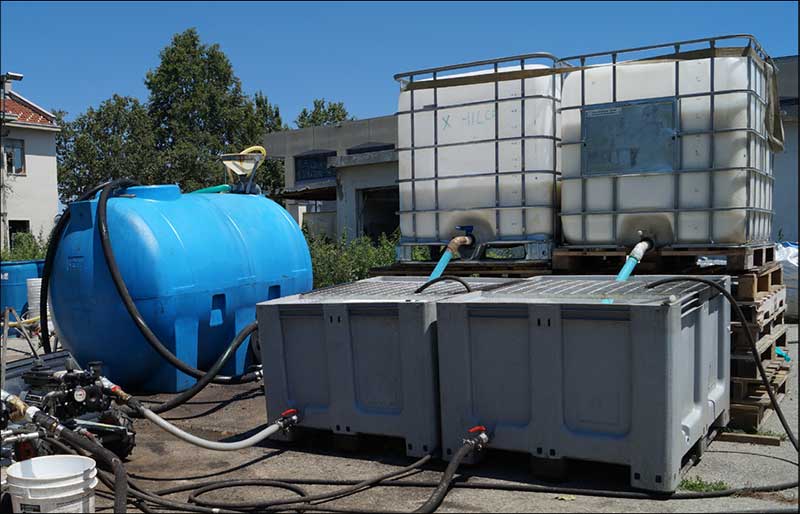 A former chemical manufacturing plant in northwest Italy was due for demolition to allow redevelopment into residential properties. Site investigations showed elevated concentrations of Cr(VI) in the groundwater, which were above the stringent National Standards of 5μg/L, requiring remedial works to be completed. The groundwater under the site is aerobic and fast-flowing, causing the contaminant plume to migrate beyond the site boundary. It was decided that an in situ approach was required to remediate the Cr(VI) prior to sale of the site.
A former chemical manufacturing plant in northwest Italy was due for demolition to allow redevelopment into residential properties. Site investigations showed elevated concentrations of Cr(VI) in the groundwater, which were above the stringent National Standards of 5μg/L, requiring remedial works to be completed. The groundwater under the site is aerobic and fast-flowing, causing the contaminant plume to migrate beyond the site boundary. It was decided that an in situ approach was required to remediate the Cr(VI) prior to sale of the site.
Site plan showing treatment areas, injection wells (pink) and monitoring well (blue) locations
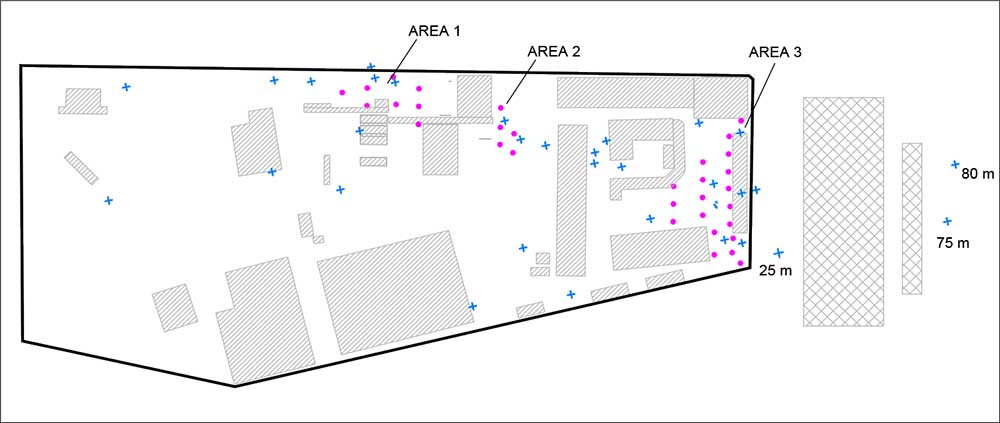
Remedial Approach
Two areas within the plume were identified as being above the site remediation target of 100μg/L. These were targeted with an injection of 3D Microemulsion (3DMe) and MRC in order to reduce the soluble Cr(VI) to non-toxic solid Cr(III) and stabilise it within the aquifer matrix.
The dose of MRC was tailored to match the vertical distribution of the contamination in order to provide the most accurate and cost effective treatment. 3DMe relies upon micellar transportation following injection in order to provide a wide radius of influence from each injection location. This was important on this deep site, in order to minimize the number of injection points required on the site.
Fixed injection points were installed and a single application of the reagents was completed. The injectable substrates were combined at a central mixing location and then pumped into several injection points simultaneously. The process was repeated until the all of the target areas were treated.
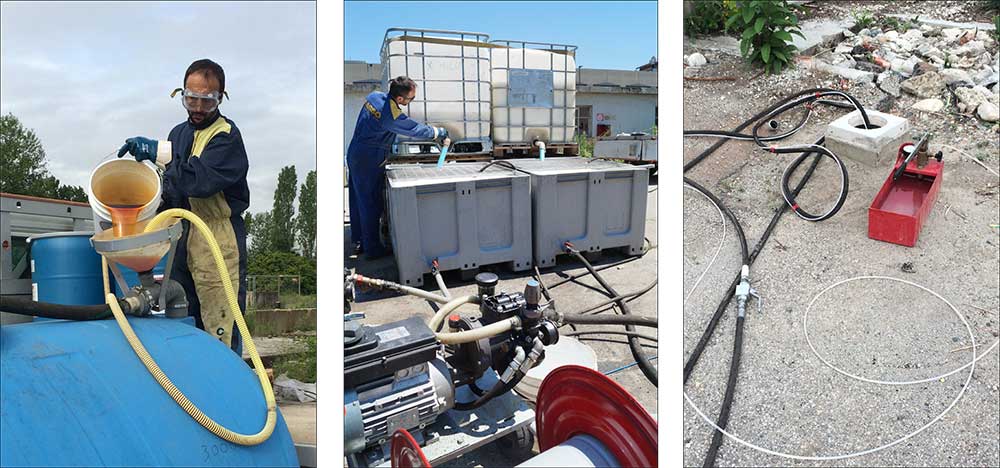
Reagent mixing and injection into fixed wells
3-D Microemulsion (3DMe)®
3DMe provides an immediate, mid-range and long-term, controlled release supply of hydrogen (electron donor) to rapidly create and then sustain anaerobic conditions. This will reduce the Cr(VI) to Cr(III), which will then settle out as a solid. Reversion to natural conditions following the 3DMe treatment (in perhaps five years or more) will not cause this process to reverse.
3DMe is also designed to distribute over very wide areas from each injection point. This is achieved through the molecule having hydrophilic and oliophilic properties hence upon mixing with water, 3DMe forms a microemulsion made of tiny micelles, which propagate through and coat the aquifer. This micelles are also able to transport MRC molecules within them, creating a wide and effective treatment zone, which is then sustained for many years.
Metals Remediation Compound (MRC)®
MRC is a controlled release remediation product designed specifically for the treatment of hexavalent chromium (Cr(VI)) in groundwater. MRC’s active compound is an ester of cysteine (a sulfur-containing amino acid) on a carbon backbone molecule of glycerol and sorbitol. A cysteine-based product such as MRC is well suited for in situ Cr(VI) immobilisation, since it has a strong affinity for metal contaminants and does not alter the properties of the subsurface. The active compound in MRC (sorbitol hexacysteinate) is embedded in a polylactate matrix that provides a carbon source and electron donor for subsurface bacteria. This combination of materials makes MRC a viscous but injectable material that slowly releases the cysteine ester to a contaminated aquifer via hydrolysis by water or enzymatic action by microbes. MRC’s slow release property allows for a longevity of 12 to 18 months in an aquifer, allowing for an effective approach to metals immobilisation.
Chromium VI concentrations in groundwater before and after treatment.
Area 1 and 2 need to reach the site remediation target, Area 3 needs to reach CSC
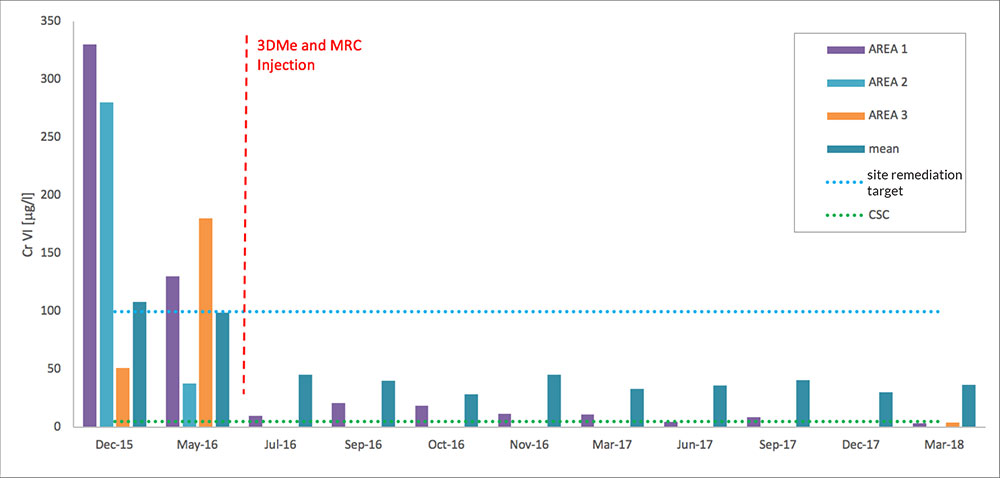
Results
Validation monitoring shows very good substrate distribution at all but one out of thirteen monitoring points. The reduction of the Oxidation- Reduction Potential (ORP) and dissolved oxygen with the simultaneous increase of the Total Organic Carbon (TOC), as well as an increase in iron and manganese, clearly showed the desired trend. The analytical results showed a rapid and significant reduction of CrVI targeting values often below the 5 μg/l limit, with a removal efficiency of 90% on average.
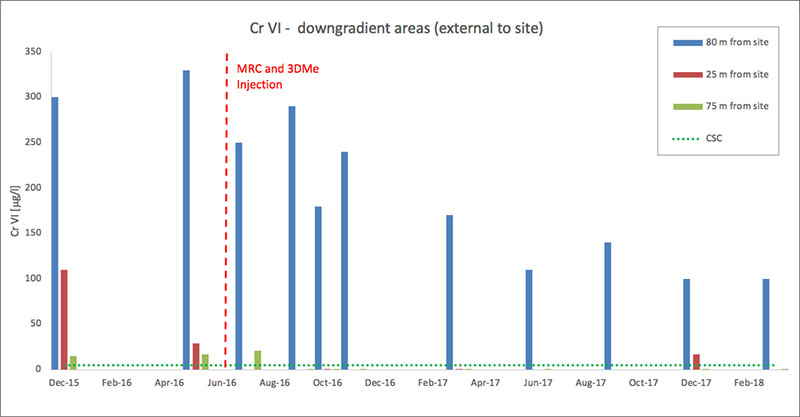
Downgradient Chromium VI concentrations at 25m (red), 75m (green) and 80m (blue) from the site
What’s Special?
- The ability of 3DMe to self-distribute over a wide radius of influence from each injection point allowed the injection grid to be widely spaced. This minimised the number of application wells, which, given the depth of the treatment, greatly reduced the remedial costs.
- Treatment of Cr(VI) was very rapid and sustained despite the aquifer being very aerobic and fast flowing.
- Even though the aquifer was very fast-flowing, the products have not suffered from wash-out and continue to successfully treat the target areas over an extended period of time.
- The seasonal variation in groundwater level at the site has the potential to mobilise contaminants into the groundwater during periods of high precipitation. The longevity of the reagents allows this contaminant influx to be addressed and avoid rebound.
- The injection technology selected saved money by avoiding the use of clustered-wells. The injection rate was high, saving time on site.
- The results of the remediation can be seen over 20m downgradient, through a significant reduction of Cr(VI) in offsite monitoring wells, providing rapid benefit to the environment on and off the site.
Historic Site On Track To Reach Remediation Goals
Case study highlights:
- Creative combined remedy approach addressed accumulated contaminants from over 100 years of manufacturing operations
- Innovative application approach using 1.5” diameter wells effectively accommodated low ceiling and tight spaces, allowing for successful reagent injection
- 180 days post-injection, all VOCs were measured at greatly reduced concentrations and geochemical conditions remain ideal for biodegradation
This case study reviews a site in the Ohio River Valley where historic industrial operations over the last 100 years at a manufacturing facility have resulted in PCE and TCE impacts to 7,500 square feet of shallow groundwater. To move the redevelopment of this site forward, groundwater VOC sample results must meet the U.S. Environmental Protection Agency maximum contaminant levels (MCLs) for four consecutive quarters. Download the case study to learn about the combined remedy using PlumeStop, HRC, and BDI+ to address the contaminants.
Combined Remedy Leads to Site Closure
Case study highlights:
- Significant contaminant reductions achieved in both the source area and core plume
- 8-10 weeks of time saved compared to alternative approaches
- $500,000 saved in project costs compared to alternative Electrical Resistance Heating (ERH) approach being considered
This case study reviews an active Underground Storage Tank (UST) case with the Arizona Department of Environmental Quality (ADEQ), where the site needed to meet ADEQ closure levels quickly in order to seek risk-based closure as part of a property transaction. After performing remedial assessment activities, the consulting firm Antea Group selected a combined remedy approach from REGENESIS, which included soil mixing using RegenOx® and H2O2 in the source zone and ISCO injections using PersulfOx® in the core plume. The solution from REGENESIS achieved ADEQ Closure levels for the site and now Antea Group is seeking a risk-based closure.

 Americas
Americas Europe
Europe Français
Français Deutsch
Deutsch Italiano
Italiano Español
Español
